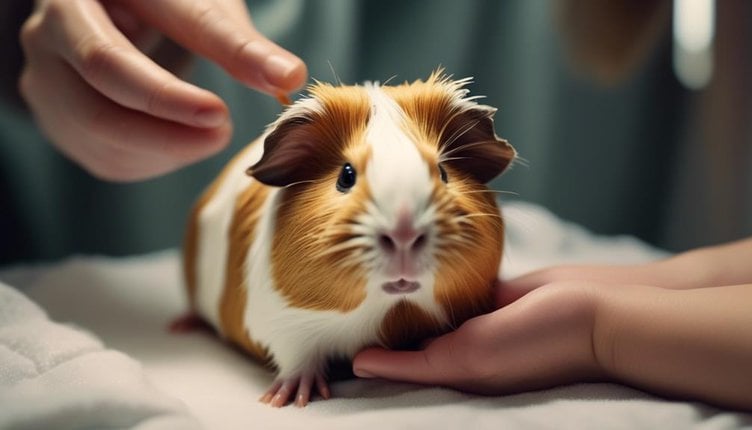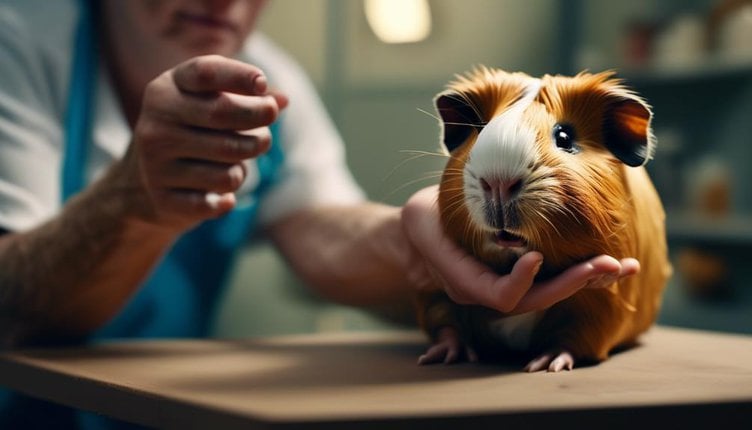Hey there, guinea pig lovers!
I gotta tell ya, pododermatitis, or bumblefoot as some folks call it, is no joke. Now, you might think it's just a little issue that doesn't need much attention, but let me tell you, that couldn't be further from the truth. This condition can cause some serious pain and if you don't treat it, it can lead to even bigger problems.
So, let's dive into the world of pododermatitis in guinea pigs and find out how to keep those tiny paws healthy and happy. Trust me, your furry friends will thank you for it!
First things first, let's talk about what causes pododermatitis. This condition usually occurs when there's too much pressure on the feet of your guinea pig. It can happen if they're walking on wire flooring or rough surfaces for extended periods of time. Poor diet, obesity, and lack of exercise can also contribute to the development of pododermatitis.
But don't worry, my friends, because prevention is the name of the game. There are some simple steps you can take to keep your guinea pig's feet in tip-top shape.
First off, make sure their living environment is comfy and cozy. Provide them with a soft bedding material, like fleece or towels, to give their feet some cushioning. Avoid wire flooring altogether, as it can be a major culprit in causing this condition.
Now, let's talk about diet and exercise. Make sure your guinea pig is getting a balanced diet that includes plenty of fresh veggies and a good quality pellet. Keep them active by providing them with toys and opportunities to run around. This will help maintain a healthy weight and reduce the risk of pododermatitis.
Lastly, regular foot checks are a must. Take a peek at those little piggies on a daily basis and look out for any signs of redness, swelling, or sores. If you spot anything suspicious, don't hesitate to consult a veterinarian. Early detection is key to preventing further complications.
So, my fellow guinea pig enthusiasts, remember that pododermatitis is not to be taken lightly. By understanding the causes and implementing preventive measures, you can ensure the well-being and comfort of your adorable little pals.
Keep those tiny paws healthy and happy, and you'll have some seriously grateful guinea pigs on your hands.
Key Takeaways
- Pododermatitis in guinea pigs is characterized by redness, swelling, inflammation, pain, and lameness on the soles of the feet.
- Regular monitoring, keeping the feet clean and dry, and using soft bedding materials can help prevent and manage pododermatitis.
- Proper foot care, such as regular inspections and nail trimming, along with maintaining a clean and dry environment, are important factors in preventing pododermatitis.
- A balanced diet with essential nutrients, including sufficient vitamin C, protein, and fiber, is crucial for healthy skin and immune function, which can help prevent pododermatitis.
Common Symptoms of Pododermatitis
Pododermatitis, also known as bumblefoot, is a condition commonly observed in guinea pigs and is characterized by a range of distinct symptoms. Guinea pigs affected by pododermatitis may exhibit redness, swelling, and inflammation on the soles of their feet. These areas may become painful and warm to the touch, causing the guinea pig to show signs of discomfort or lameness. In severe cases, the skin on the affected areas may develop ulcers or open sores, which can lead to infection if left untreated.
Proper management of the symptoms is crucial in ensuring the well-being of guinea pigs with pododermatitis. Regular monitoring of the affected areas is essential to detect any changes or signs of worsening. Keeping the affected areas clean and dry is crucial to prevent the spread of infection. The use of appropriate bedding materials, such as soft towels or fleece liners, can help reduce the pressure on the guinea pig's feet and minimize the risk of developing pododermatitis.
Prevention strategies play a vital role in reducing the incidence of pododermatitis in guinea pigs. Providing a spacious and clean living environment is essential, as overcrowding and unsanitary conditions can contribute to the development of the condition. Regularly checking the guinea pig's feet for any signs of redness or swelling can help identify the early stages of pododermatitis and allow for prompt intervention. Additionally, ensuring a well-balanced diet and maintaining a healthy body weight can help prevent excessive pressure on the feet, reducing the risk of developing pododermatitis.
Factors That Contribute to Pododermatitis
Factors that contribute to the development of pododermatitis in guinea pigs include proper foot care and the choice of bedding materials. Guinea pigs have sensitive feet, so it is important to provide them with appropriate foot care to reduce the risk of pododermatitis. Regular foot inspections are crucial for early detection of any signs of irritation or injury. Trimming the guinea pig's nails regularly is also important to prevent overgrowth, which can lead to discomfort and foot problems.
Maintaining a clean and dry environment is vital in minimizing the risk of pododermatitis. The choice of bedding materials is crucial in this regard. Soft and absorbent bedding materials like fleece or paper-based bedding can help prevent pressure sores and provide a comfortable surface for the guinea pig to rest and move around on.
It is important to avoid using materials like cedar or pine shavings, as they can be abrasive and release harmful chemicals that may irritate the guinea pig's feet.
Understanding the Role of Diet in Pododermatitis

The guinea pig's diet plays a crucial role in maintaining foot health and preventing pododermatitis. Nutritional deficiencies can weaken the skin and predispose guinea pigs to lesions and infections.
A balanced diet that includes a variety of fresh vegetables, hay, and a high-quality pellet feed can provide the necessary nutrients to support healthy skin and prevent pododermatitis.
Diet and Foot Health
Maintaining a well-balanced diet is essential for promoting healthy foot health and preventing pododermatitis in guinea pigs. While diet alone may not be the sole cause of pododermatitis, it plays a crucial role in the overall foot health of these animals.
A diet that lacks essential nutrients can weaken the immune system, making guinea pigs more susceptible to foot problems. Providing a diet rich in vitamin C, calcium, and protein is important for the formation and maintenance of healthy foot tissues.
Additionally, a diet that's high in fiber promotes proper digestion and prevents obesity, which can put excess pressure on the feet. It's also important to note that genetics can play a role in the development of pododermatitis. Some guinea pigs may be genetically predisposed to foot problems, making it even more crucial to provide them with a well-balanced diet to support their foot health.
Nutritional Impact on Pododermatitis
A well-balanced diet rich in essential nutrients is crucial for preventing pododermatitis in guinea pigs and maintaining their foot health. Nutritional deficiencies can weaken the guinea pig's immune system and compromise the integrity of their skin, making them more susceptible to developing pododermatitis.
Here are four key points to consider when it comes to the nutritional impact on pododermatitis:
- Proper vitamin C intake: Guinea pigs can't synthesize vitamin C on their own, so it's essential to provide them with a diet that includes sufficient amounts of this nutrient. Vitamin C plays a vital role in collagen synthesis, which is crucial for healthy skin and foot pad integrity.
- Adequate protein levels: Protein is necessary for tissue repair and regeneration. It helps maintain the strength and elasticity of the skin, reducing the likelihood of foot injuries that can lead to pododermatitis.
- Sufficient fiber intake: A diet rich in fiber promotes proper digestion and gut health in guinea pigs. This, in turn, helps prevent diarrhea and other digestive issues that can contribute to pododermatitis.
- Impact of exercise: Regular exercise is essential for guinea pigs to maintain a healthy weight and muscle tone. Being overweight or sedentary can increase the risk of developing pododermatitis. Encouraging exercise through providing ample space and opportunities for physical activity can help prevent this condition.
Importance of Proper Cage Setup and Flooring
Properly setting up and choosing suitable flooring for a guinea pig's cage is essential in preventing pododermatitis. Guinea pigs are highly susceptible to developing this painful condition, which is characterized by inflammation and infection of the feet, primarily due to poor husbandry practices. When it comes to cage setup, there are two crucial aspects to consider: proper bedding and appropriate cage size.
In order to provide a comfortable and sanitary environment for your guinea pig, it is important to select the right bedding material. Opt for bedding that is soft, absorbent, and dust-free. Materials such as paper bedding, hay, or fleece liners are commonly recommended. Avoid using wood shavings, as they can cause respiratory issues and may contain harmful chemicals.
Additionally, the size of the cage plays a significant role in preventing pododermatitis. Guinea pigs require ample space to roam, exercise, and engage in natural behaviors. A cage that is too small can lead to restricted movement and increased pressure on the feet. As a general guideline, a single guinea pig should have a cage size of at least 7.5 square feet, while a pair or small group of guinea pigs should have a cage size of at least 10.5 square feet.
By ensuring proper bedding and providing an adequately sized cage, guinea pig owners can significantly reduce the risk of pododermatitis and promote the overall well-being of their furry companions.
| Proper Bedding | Appropriate Cage Size |
|---|---|
| Soft, absorbent, | Single guinea pigs: |
| dust-free materials | 7.5 square feet |
| such as paper bedding, | |
| hay, or fleece liners | Pair or small group |
| of guinea pigs: | |
| 10.5 square feet |
Hygiene Practices to Prevent Pododermatitis

To ensure the prevention of pododermatitis in guinea pigs, implementing effective hygiene practices is crucial for maintaining their foot health. Guinea pigs are prone to developing foot sores and infections, which can be painful and lead to serious complications if left untreated. By following proper hygiene practices, owners can significantly reduce the risk of pododermatitis and promote the overall well-being of their furry companions.
Here are four important hygiene practices to consider:
- Regular cage cleaning: Guinea pig cages should be cleaned on a regular basis to remove any urine or feces that may accumulate. This helps prevent the growth of bacteria and fungi that can contribute to pododermatitis.
- Proper bedding selection: Choosing the right bedding is essential for foot care. Owners should opt for soft, absorbent bedding that provides cushioning and prevents excessive pressure on the guinea pig's feet.
- Foot inspections: Regularly inspecting your guinea pig's feet is important for early detection of any signs of pododermatitis. Look for redness, swelling, sores, or any unusual discharge. If any abnormalities are found, consult a veterinarian immediately.
- Nail trimming: Overgrown nails can cause discomfort and increase the risk of foot injury. Regular nail trimming helps maintain proper foot health and reduces the likelihood of pododermatitis.
Regular Foot Care for Guinea Pigs
Regular foot care is essential for maintaining the health and well-being of guinea pigs. Proper foot care not only prevents pododermatitis but also ensures that guinea pigs can move comfortably and engage in their natural behaviors. There are various foot care products available in the market that can help in maintaining healthy guinea pig feet. These products include nail clippers, specifically designed for small animals, and foot creams or balms that provide moisturization and protection to the feet. It is important to choose products that are safe and suitable for guinea pigs, as their skin can be sensitive.
In addition to using foot care products, guinea pig owners can also practice DIY foot care at home. This includes regularly inspecting the guinea pig's feet for any signs of redness, swelling, or sores. Trimming the nails is another important aspect of foot care. Overgrown nails can cause discomfort and affect the guinea pig's ability to walk properly. However, care should be taken not to cut the nails too short, as it can cause bleeding and pain.
To provide further guidance on foot care for guinea pigs, refer to the following table:
| Foot Care Product | Purpose | Recommended Usage |
|---|---|---|
| Nail clippers | Trimming nails | Trim nails every 3-4 weeks |
| Foot cream/balm | Moisturization and | Apply a thin layer on the feet once a week |
| protection |
Seeking Veterinary Care for Pododermatitis Treatment

When it comes to treating pododermatitis in guinea pigs, seeking veterinary care is essential. Veterinarians play a crucial role in the treatment process, as they have the expertise and knowledge to properly diagnose the condition and recommend appropriate treatment options.
Early intervention is key to preventing the progression of pododermatitis, so it's important for guinea pig owners to promptly seek veterinary care at the first sign of foot problems.
Veterinarian's Role in Treatment
Veterinarians play a crucial role in the treatment of pododermatitis, providing essential expertise and guidance to effectively address the condition in guinea pigs. Their in-depth knowledge of the disease allows them to diagnose the underlying causes and recommend appropriate treatment options. Here are four ways in which veterinarians contribute to the care of guinea pigs with pododermatitis:
- Accurate Diagnosis: Veterinarians conduct thorough examinations to identify the specific factors contributing to pododermatitis, such as improper bedding or bacterial infections. This precise diagnosis ensures targeted treatment.
- Treatment Plans: Based on their expertise, veterinarians develop comprehensive treatment plans tailored to each guinea pig's needs. These plans may include wound care, pain management, and changes in diet or habitat.
- Medications and Therapies: Veterinarians prescribe medications, such as antibiotics or anti-inflammatory drugs, to alleviate pain and combat infections. They may also recommend therapeutic interventions, like wound dressings or physical therapy, to promote healing.
- Ongoing Monitoring and Support: Veterinarians provide regular follow-up care, monitoring the progress of treatment and adjusting the plan as needed. They offer guidance on proper nutrition, hygiene, and preventive measures to minimize the risk of recurrence.
With a veterinarian's expertise and guidance, guinea pigs with pododermatitis can receive the comprehensive care necessary for a successful recovery.
Importance of Early Intervention
Building on the crucial role veterinarians play in treating pododermatitis in guinea pigs, early intervention through seeking veterinary care is essential for effectively addressing this condition and promoting successful treatment outcomes.
The benefits of early intervention can't be overstated. When pododermatitis is detected and treated promptly, it minimizes the risk of complications and reduces the severity of the condition.
Delaying treatment, on the other hand, can have serious consequences. If left untreated, pododermatitis can progress rapidly, leading to pain, discomfort, and infection for the affected guinea pig. Additionally, delayed treatment may require more aggressive and prolonged interventions, increasing the stress on both the guinea pig and their caregiver.
Treatment Options and Recommendations
Seeking prompt veterinary care is crucial for effectively treating pododermatitis in guinea pigs and ensuring the best possible outcome for their recovery. When it comes to treatment options and recommended care, here are four key points to consider:
- Veterinary Examination: A thorough examination by a veterinarian is essential to determine the severity of the condition and identify any underlying causes.
- Medications: Treatment may involve the use of topical or oral medications to reduce inflammation, control infection, and relieve pain.
- Wound Management: Proper wound care is vital for healing. This may include cleaning the affected area, applying topical ointments or dressings, and implementing preventive measures to avoid further trauma.
- Environmental Modifications: Making changes to the guinea pig's living environment is crucial for preventing recurrence. This may involve providing soft bedding, ensuring cleanliness, and creating a spacious and well-maintained enclosure.
Frequently Asked Questions
What Are Some Common Treatments for Pododermatitis in Guinea Pigs?
Common treatments for pododermatitis in guinea pigs include topical antibiotics, pain management, and regular cleaning of the affected area. Home remedies such as warm soaks and keeping the cage clean can also help alleviate symptoms.
Can Pododermatitis Be Prevented Entirely With Proper Cage Setup and Flooring?
Proper cage setup and flooring can effectively prevent pododermatitis in guinea pigs. By providing suitable bedding materials and surfaces that are soft, clean, and supportive, owners can significantly reduce the risk of this condition.
Are Some Guinea Pig Breeds More Prone to Developing Pododermatitis Than Others?
Some guinea pig breeds may be more prone to developing pododermatitis than others due to genetic factors. These differences in breed susceptibility should be considered when selecting a guinea pig to ensure their overall well-being and minimize the risk of pododermatitis.
Can Pododermatitis Be Contagious Among Guinea Pigs?
Pododermatitis cannot be transmitted between guinea pigs. This condition is not contagious. However, it is important to be aware of the symptoms and diagnosis in order to provide proper care and prevent its occurrence.
How Long Does It Typically Take for Pododermatitis to Heal With Proper Treatment and Care?
Pododermatitis healing time can vary depending on the severity of the condition and the treatment options chosen. With proper treatment and care, it typically takes a few weeks for pododermatitis to heal in guinea pigs.





